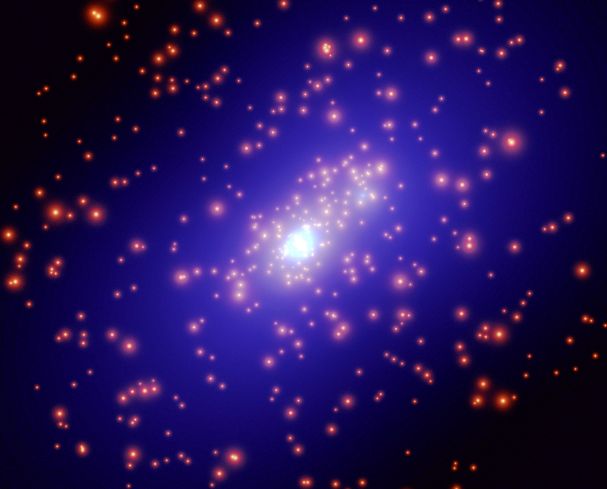Explanation: The total mass within giant galaxy cluster CL0025+1654, about 4.5 billion light-years away, produces a cosmic gravitational lens -- bending light as predicted by Einstein's theory of gravity and forming detectable images of even more distant background galaxies. Of course, the total cluster mass is the sum of the galaxies themselves, seen as ordinary luminous matter, plus the cluster's invisible dark matter whose nature remains unknown. But by analyzing the distribution of luminous matter and the properties of the gravitational lensing due to total cluster mass, researchers have solved the problem of tracing the dark matter layout. Their resulting map shows the otherwise invisible dark matter in blue, and the positions of the cluster galaxies in yellow. The work, based on extensive Hubble Space Telescope observations, reveals that the cluster's dark matter is not evenly distributed, but follows the clumps of luminous matter closely.
1999 2000 2001 2002 2003 2004 2005 2006 2007 2008 2009 2010 2011 2012 2013 2014 2015 2016 2017 2018 2019 2020 2021 2022 2023 2024 2025 |
Yanvar' Fevral' Mart Aprel' Mai Iyun' Iyul' Avgust Sentyabr' Oktyabr' Noyabr' Dekabr' |
NASA Web Site Statements, Warnings, and Disclaimers
NASA Official: Jay Norris. Specific rights apply.
A service of: LHEA at NASA / GSFC
& Michigan Tech. U.
|
Publikacii s klyuchevymi slovami:
dark matter - cluster of galaxies - gravitational lens - temnaya materiya - Skoplenie galaktik - gravitacionnaya linza
Publikacii so slovami: dark matter - cluster of galaxies - gravitational lens - temnaya materiya - Skoplenie galaktik - gravitacionnaya linza | |
Sm. takzhe:
Vse publikacii na tu zhe temu >> | |
